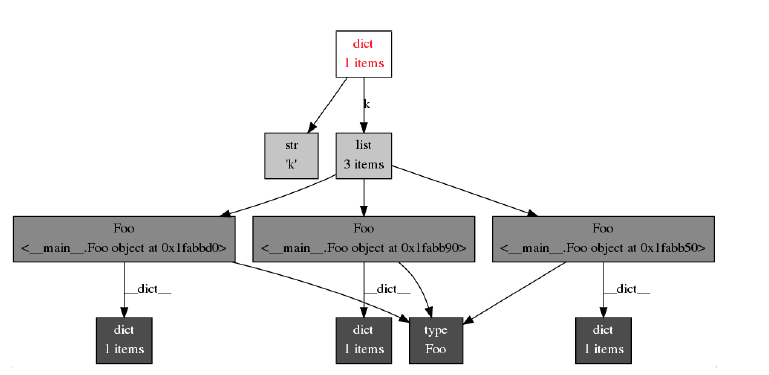(点击
上方公众号
,可快速关注)
译文:开源中国
英文:dzone
链接:oschina.net/translate/python-memory-issues-tips-and-tricks
Python 打算删除大量涉及像C和C++语言那样的复杂内存管理。当对象离开范围,就会被自动垃圾收集器回收。然而,对于由 Python 开发的大型且长期运行的系统来说,内存管理是不容小觑的事情。
在这篇博客中,我将会分享关于减少 Python 内存消耗的方法和分析导致内存消耗/膨胀根源的问题。这些都是从实际操作中总结的经验,我们正在构建 Datos IO 的 RecoverX 分布式备份和恢复平台,这里主要要介绍的是在 Python(在 C++ ,Java 和 bash 中也有一些类似的组件) 中的开发。
Python 垃圾收集
Python解释器对正在使用的对象保持计数。当对象不再被引用指向的时候,垃圾收集器可以释放该对象,获取分配的内存。例如,如果你使用常规的Python(CPython, 不是JPython)时,Python的垃圾收集器将调用free()/delete() 。
实用工具
资源(resource)
resource’
模块用来查看项目当前得的固有的)内存消耗
[固有内存是项目实际使用的RAM]
>>>
import
resource
>>>
resource
.
getrusage
(
resource
.
RUSAGE_SELF
).
ru
_
maxrss
4332
对象(objgraph)
objgraph’ 是一个实用模块,可以展示当前内存中存在的对象
[objgraph 文档和实例地址: https://mg.pov.lt/objgraph/]
来看看objgraph的简单用法:
import
objgraph
import
random
import
inspect
class
Foo
(
object
)
:
def
__init__
(
self
)
:
self
.
val
=
None
def
__str__
(
self
)
:
return
“
foo
–
val
:
{
0
}
”
.
format
(
self
.
val
)
def
f
()
:
l
=
[]
for
i
in
range
(
3
)
:
foo
=
Foo
()
#print “id of foo: {0}”.format(id(foo))
#print “foo is: {0}”.format(foo)
l
.
append
(
foo
)
return
l
def
main
()
:
d
=
{}
l
=
f
()
d
[
‘
k
’
]
=
l
print
“
list
l
has
{
0
}
objects of type
Foo
()
”
.
format
(
len
(
l
))
objgraph
.
show_most_common_types
()
objgraph
.
show_backrefs
(
random
.
choice
(
objgraph
.
by_type
(
‘
Foo
’
)),
filename
=
“
foo_refs
.
png
”
)
objgraph
.
show_refs
(
d
,
filename
=
‘
sample
-
graph
.
png
’
)
if
__name__
==
“
__main__
”
:
main
()
python
test1
.
py
list
l
has
10000
objects of type
Foo
()
dict
10423
Foo
10000
————
>
Guilty
as
charged
!
tuple
3349
wrapper
_
descriptor
945
function
860
builtin_function_or
_
method
616
method
_
descriptor
338
weakref
199
member
_
descriptor
161
getset
_
descriptor
107
注意,我们在内存中还持有10,423个‘dict’的实例对象。
可视化objgraph依赖项
Objgraph有个不错的功能,可以显示Foo()对象在内存中存在的因素,即,显示谁持有对它的引用 (在这个例子中是list ‘l’)。
在RedHat/Centos上, 你可以使用sudo yum install yum install graphviz*安装graphviz
如需查看对象字典,d,请参考:
objgraph.show_refs(d, filename=’sample-graph.png’)

从内存使用角度来看,我们惊奇地发现——为什么对象没有释放?这是因为有人在持有对它的引用。
这个小片段展示了objgraph怎样提供相关信息:
objgraph
.
show_backrefs
(
random
.
choice
(
objgraph
.
by_type
(
‘
Foo
’
)),
filename
=
“
foo_refs
.
png
”
)

在这一案例中, 我们查看了Foo类型的随机对象。我们知道该特定对象被保存在内存中,因其引用链接在指定范围内。
有时,以上技巧能帮助我们理解,为什么当我们不再使用某对象时,Python垃圾回收器没有将垃圾回收。
难处理的是,有时候我们会发现Foo()占用了很多内存的类。这时我们可以用heapy()来回答以上问题。
Heapy
heapy 是一个实用的,用于调试内存消耗/泄漏的工具。查看 http://guppy-pe.sourceforge.net/。通常,我将objgraph和heapy搭配使用:用 heapy 查看分配对象随时间增长的差异,heapy能够显示对象持有的最大内存等;用Objgraph找backref链(例如:前4节),尝试获取它们不能被释放的原因。
Heapy的典型用法是在不同地方的代码中调用一个函数,试图为内存使用量提供大量收集线索,找到可能会引发的问题:
from
guppy
import
hpy
def
dump_heap
(
h
,
i
)
:
“””
@
param
h
:
The heap
(
from
hp
=
hpy
(),
h
=
hp
.
heap
())
@
param
i
:
Identifier str
“””
print
“
Dumping stats
at
:
{
0
}
”
.
format
(
i
)
print
‘
Memory
usage
:
{
0
}
(
MB
)
’
.
format
(
resource
.
getrusage
(
resource
.
RUSAGE_SELF
).
ru_maxrss
/
1024
)
print
“
Most common types
:
”
objgraph
.
show_most_common_types
()
print
“
heap
is
:
”
print
“
{
0





